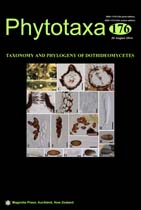Abstract
The family Trichopeltinaceae is poorly known. This is due to an unclear history, few modern morphological studies and lack of sequence data in GenBank. The family was introduced in 1914 as Trichopeltaceae to accommodate the subfamilies Trichopeltinae and Brefeldiineae. In 1958 the spelling of the family was corrected to Trichopeltinaceae, as it was presumably based on the genus Trichopeltina. The family Brefeldiellaceae was introduced in 1962. Both Brefeldiellaceae and Trichopeltinaceae contain morphologically similar epiphgytic foliar taxa, the only difference being that the thallus is linear in Trichopeltinaceae and rounded in Brefeldiellaceae. In both families the thallus forms a neatly arranged, “skin-like”, palisade of cells over the flattened thyriothecia, pseudoparaphyses are mostly lacking, asci are bitunicate and saccate and ascospores are ellipsoidal, muriform of trans-septate and hyaline to brown. Trichopeltinaceae is the earliest name for these taxa. The family can be confused with Trichothyriaceae and this is discussed. A new species of Trichopeltina is also introduced and illustrated.

